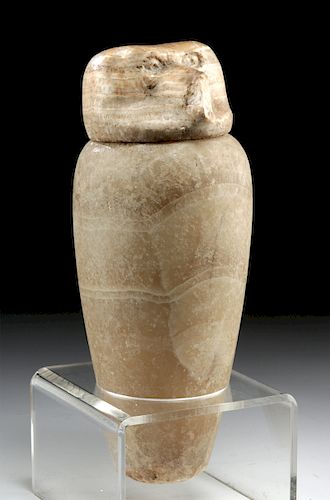Egyptian Calcite Alabaster Canopic Jar w/ Baboon Lid
Lot 14b
About Seller
Artemis Fine Arts
686 S Taylor Ave, Ste 106
Louisville, CO 80027
United States
Selling antiquities, ancient and ethnographic art online since 1993, Artemis Gallery specializes in Classical Antiquities (Egyptian, Greek, Roman, Near Eastern), Asian, Pre-Columbian, African / Tribal / Oceanographic art. Our extensive inventory includes pottery, stone, metal, wood, glass and textil...Read more
Estimate:
$7,000 - $10,000
Absentee vs Live bid
Two ways to bid:
- Leave a max absentee bid and the platform will bid on your behalf up to your maximum bid during the live auction.
- Bid live during the auction and your bids will be submitted real-time to the auctioneer.
Bid Increments
| Price | Bid Increment |
|---|---|
| $0 | $25 |
| $300 | $50 |
| $1,000 | $100 |
| $2,000 | $250 |
| $5,000 | $500 |
| $10,000 | $1,000 |
| $20,000 | $2,500 |
| $50,000 | $5,000 |
| $100,000 | $10,000 |
| $200,000 | $20,000 |
About Auction
By Artemis Fine Arts
Sep 26, 2019
Set Reminder
2019-09-26 10:00:00
2019-09-26 10:00:00
America/New_York
Bidsquare
Bidsquare : Exceptional Day 1: Antiquities & Asian Art
https://www.bidsquare.com/auctions/artemis-gallery/exceptional-day-1-antiquities-asian-art-4437
Day 1 of an important 2-day auction featuring exceptional, museum-worthy examples of Egyptian, Greek, Etruscan, Roman, Viking, Russian, Near Eastern, as well as Asian Art from China, Japan, Thailand, Vietnam, Burma and India. Artemis Fine Arts info@artemisfinearts.com
Day 1 of an important 2-day auction featuring exceptional, museum-worthy examples of Egyptian, Greek, Etruscan, Roman, Viking, Russian, Near Eastern, as well as Asian Art from China, Japan, Thailand, Vietnam, Burma and India. Artemis Fine Arts info@artemisfinearts.com
- Lot Description
Egypt, Late Dynastic Period, 26th to 31st Dynasty, ca. 664 to 332 BCE. A handsome canopic jar, hand-carved from honey-yellow calcite alabaster with natural veins that illuminate when held next to a bright light. The cylindrical vessel has a flat base, an inverted piriform body with a slightly swelled shoulder, a flat upper rim, and a deep interior cavity meant to contain and protect the mummy's internal organs. The jar lid has a squat lower tenon and is sculpted to emulate the head of a baboon with recessed, discoid eyes beneath furrowed brow ridge, a lobed mane surrounding the face, a crested nasal ridge, and a tapered snout. The exterior of both body and lid has an incredibly smooth texture that creates a pleasing tactile feel. Size: 5.375" W x 13" H (13.7 cm x 33 cm); 14.1" H (35.8 cm) on included custom stand.
Canopic jars are some of the most iconic artifacts from Egypt, made to hold internal organs removed during the mummification process. This tradition lasted for an incredibly long time - the first evidence for a canopic chest containing organs comes from the Fourth Dynasty (ca. 2600 BCE) and they were used into the late 1st millennium BCE. The 18th Dynasty marked a shift in canopic jar tradition, when these jars were given to all people of status, and when their heads were fashioned to look like the four Sons of Horus, including Hapi. The Four Sons were charged with protecting the internal organs, as they had originally been charged with protecting the body of Osiris. The baboon-headed son who represented the north, Hapi, was charged with protecting the lungs of the deceased and was protected by the goddess Nephthys.
A stylistically similar example, of a slightly taller size and with an frontal inscription, hammered for $21,250 at Sotheby's, New York "Antiquities" auction (June 8, 2011, lot 94): https://www.sothebys.com/en/auctions/ecatalogue/2011/antiquities-n08762/lot.94.html
Provenance: private J.H. collection, Beaverton, Oregon, USA
All items legal to buy/sell under U.S. Statute covering cultural patrimony Code 2600, CHAPTER 14, and are guaranteed to be as described or your money back.
A Certificate of Authenticity will accompany all winning bids.
We ship worldwide and handle all shipping in-house for your convenience.
#149687Losses to areas of baboon snout on lid as shown. Minor chips to base and upper rim of body as well as lower tenon and head of lid, with light encrustations, and softening to some finer details on lid. Nice earthen deposits and smooth patina throughout.Condition
- Shipping Info
-
All shipping is handled in-house for your convenience. Your invoice from Artemis Gallery will include shipping calculation instructions. If in doubt, please inquire BEFORE bidding for estimated shipping costs for individual items.
-
- Buyer's Premium



 EUR
EUR CAD
CAD AUD
AUD GBP
GBP MXN
MXN HKD
HKD CNY
CNY MYR
MYR SEK
SEK SGD
SGD CHF
CHF THB
THB















